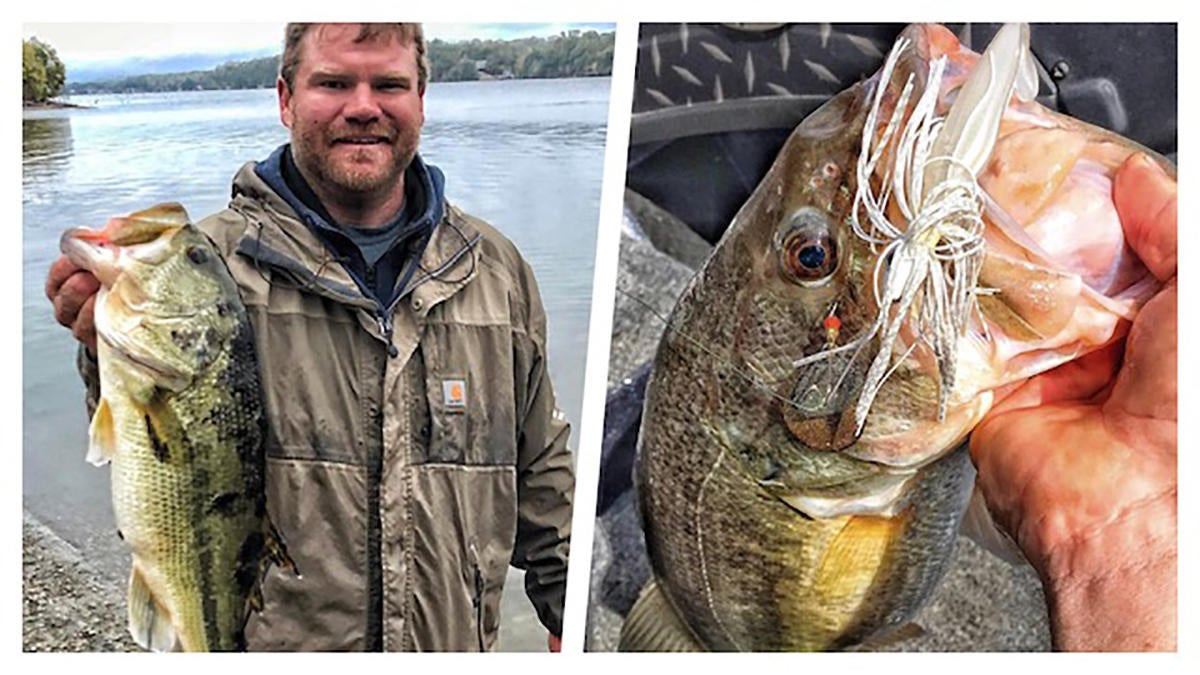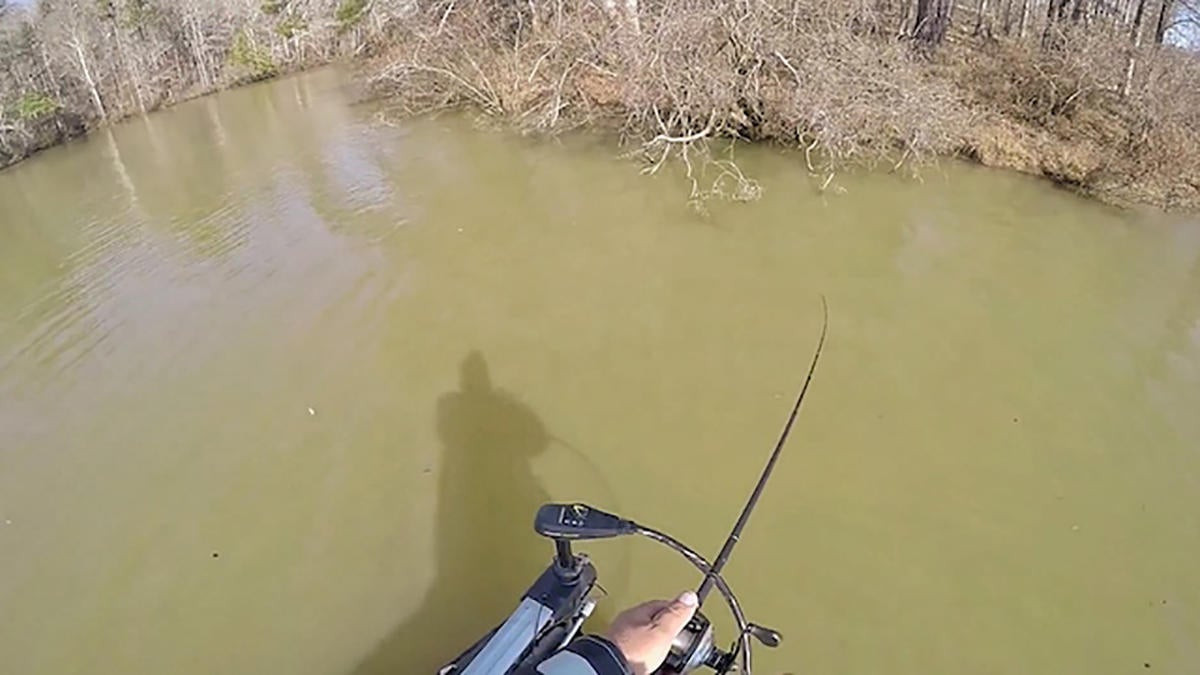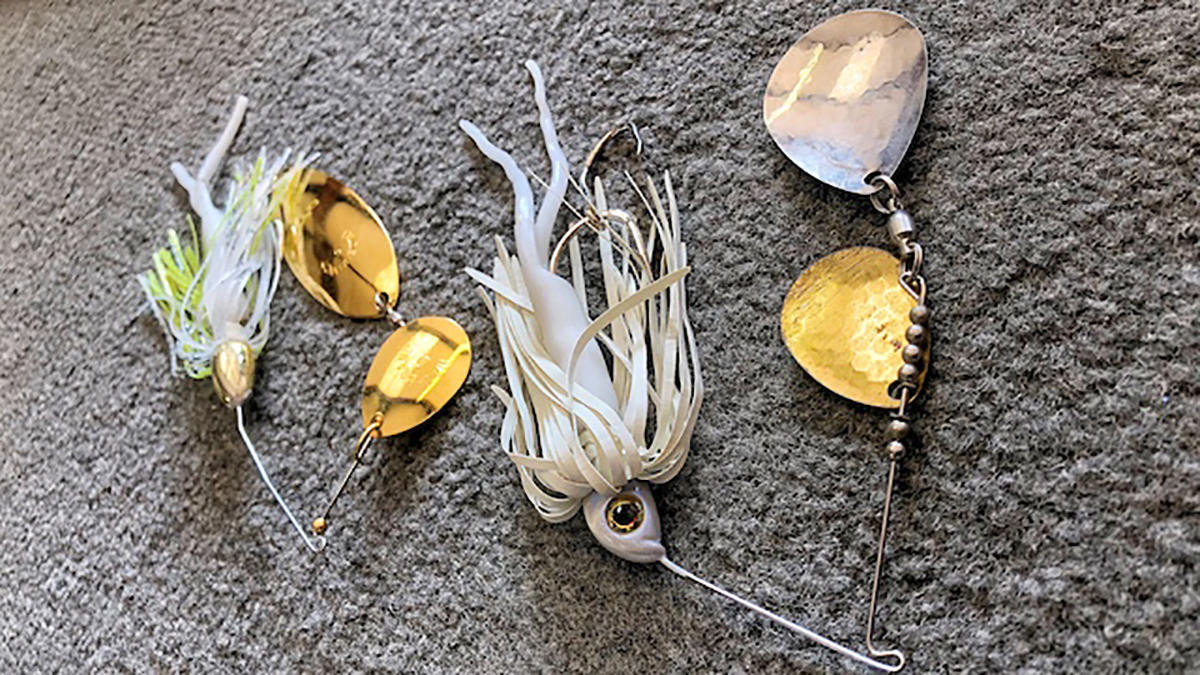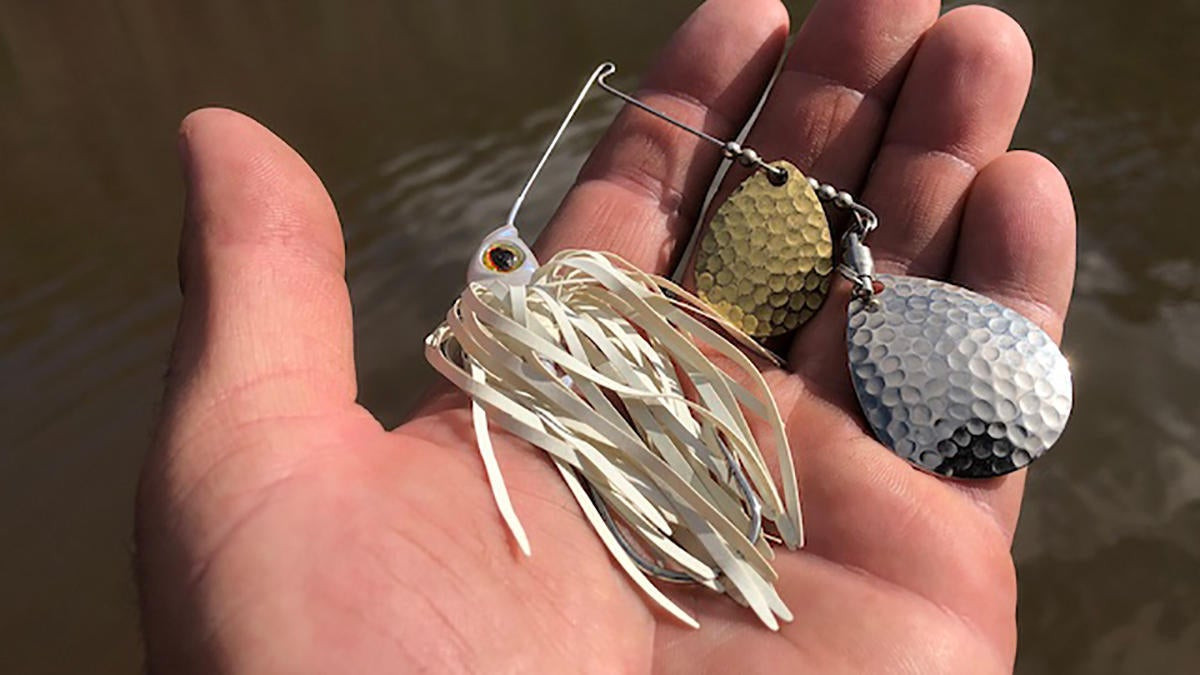Slow rolling a spinnerbait is one of the best ways to catch quality fish in shallow, cold and stained water. My father taught me that at a very young age.
December 8, 1986, five days after I was born, my dad caught the biggest fish he’s ever caught in his life slow rolling a spinnerbait — a 38-pound striper. Though he was admittedly fishing for largemouth, he relished the “Old Man and the Sea”-style epic battle that ensued. A story I hear each time we cast by what’s left of that log, which is quite often.
The fish couldn’t have been sitting in 18 inches of water when it bit, but it annihilated his spinnerbait and took off. In a couple of seconds he knew that this wasn’t the quarry he was after but a big, mean stripe instead.
The fish made run after run, stripping drag from his reel and turning and pulling his boat. With each revolution of the reel, dad started to feel the knot getting closer and closer to the top of his spool. The knot where he had added new line to his reel and tied it to the older backing. A knot he tied in haste, assuming it would never see the light of day again.
He knew if that knot made it out of the reel, the fight was over. It would never hold under this kind of pressure and the fish would be gone. About the time that crossed his mind, the knot escaped his reel. Dad said it looked like a chinaberry headed through his rod guides and he cringed as he heard it pluck over each one. But the knot held, and the fight raged on.
The fish inevitably reached the spool of my father’s reel, even with him chasing after it on the trolling motor as fast as he could. But by then, the beast had started to tire. Dad worked to reclaim his backing knot, feeling certain if he could get back to that point he’d eventually prevail in this tug of war. After a 30-minute battle being pulled all over the lake, he finally boated the fish a couple hundred yards from where it had bit.
I was five days old and I still haven’t forgiven him for not taking me with him, seeing as how I was his new “proteshaye” (see what I did there?) and all.
Granted this is an article about slow rolling spinnerbaits for largemouth bass, but I tell you this story to illustrate a simple fact—big fish stay shallow even in really cold water. And when it comes to catching them, a spinnerbait is a great tool for the job.
When the water has a decent amount of color to it and the water temps are in the upper 40s to mid 50s, bass don’t like to move far or fast and they’re primarily relying on feel instead of sight in order to feed. So slow rolling a spinnerbait along is a great way to offer them a big meal that’s easy to track and worth expending a little energy for.
How and where
You want to focus on water between 1 and 5 feet deep with at least a little stain to it. The water can be as muddy as it gets, but doesn’t have to be. Mainly just anything from chocolate milk to no more than 18 inches or so of visibility. You want to keep the bait close to the bottom when you can, fishing it just as slowly as possible while still keeping the bait upright and the blades turning.
Wood has always been the focal point with this technique for us here in central Alabama. Stumps, logs and brush piles offer great refuge for a lethargic wintertime bass. But you can certainly catch fish slow rolling a spinnerbait around docks, rocks, vegetation or whatever shallow cover you have an abundance of. You just want to make sure you get the bait as close to the cover as possible. And go ahead and accept you’re going to get snagged some. As my dad always says, “If you’re not getting hung, you’re not throwing where the fish are.”
But there are ways to limit the number of times you get hung. The main one is to always keep your bait upright. The blade arm of a spinnerbait is a natural weed guard and as long as the bait is upright, the bottom of the hook will actually slide the bait over most of the cover. But if you let the bait roll to one side, you’re snagged every time.
Keeping the bait upright doesn’t seem that difficult, until you consider this next part. It makes sense that if you just keep reeling the bait at a steady pace it wouldn’t roll over. But the trick to getting bit while slow rolling a spinnerbait is adding a little extra action. Most of the bites won’t come during a steady retrieve. You want to twitch your rod tip every few seconds to make the bait kick a little. The blades will flash a little differently and the skirt will flare. That’s typically when you’ll get a bite from a fish trailing your bait.
The other key to getting bit also offers an opportunity for the bait to roll over and hang up. “Killing” a spinnerbait is one of the most effective ways to draw a strike from a bass staged near cover. Just after you bring the bait over a piece of cover, you want to pause and let the bait fall. That’s when a bass sitting alongside the cover has typically seen all it can stand and inhales the bait on the fall. It’s awesome.
The only hang up is the whole hanging up part. So as the bait falls, you want to try to keep a semi-slack line where the bait just barely falls forward and stays mostly upright as it nosedives. If you completely quit reeling and drop your rod tip, the bait will roll over and hang up or sometimes you even miss a fish because the bass hammers the bait and then spits it before you can set the hook. You want the bait to kind of glide slightly away from the cover and let the pull of the blades help it stay as upright as possible.
Gear for the job
So what do these spinnerbaits look like? Well for years and years, we primarily fished this way with a white 3/8-ounce spinnerbait with double Colorado blades-sizes 4 and 6. And that’s still what we use in muddy to really muddy water.
But over the last couple years, we’ve added a big 1/2-ounce willow leaf spinnerbait to the arsenal and started slow rolling it in slightly less than muddy situations. Any water with a decent amount of color to it will do. This spinnerbait is chartreuse with gold blades-a No. 4 Colorado and a No. 6 willow leaf.
Both of these baits have the thump you want in cold water. Dad says reeling in the big willow leaf one is like trying to reel in a tricycle, which understandably doesn’t make a lot of sense at first but once you try it, you’ll get it.
The resistance of the big blades on both these baits not only helps the fish locate them, but also helps slow the way you fish them down. When the water is hovering around the 50-degree mark, you want to fish a spinnerbait very slowly. The beauty of these bigger blades is that they’ll make the bait ride high in the water column if you don’t slow down. So you’re forced to fish slow in order to keep the bait down. Basically, you want to just barely feel the blades turning.
Feel is very important with everything relative to slow rolling a spinnerbait. Being able to feel the blades turning slow, being able to feel if a little debris gets on the blade so you can pump your rod tip to get it spinning again, being able to feel the difference between bumping a log and a bite. Feel is paramount. That’s why I slow roll a spinnerbait on 40-pound Sufix 832 Braided Line.
I know a lot of great fishermen who fish a spinnerbait on fluorocarbon or even monofilament. And they have their reasons. I don’t dispute or discredit them. But for me, I was raised on braided line and I am very comfortable with it. It would be very difficult for me to fish this way without the added sensitivity braid offers. Not to mention the critical added strength.
This type of fishing can be rather violent, which is another reason I love the braided line. And why I go with an oversized rod compared to most other spinnerbait applications. Where many anglers will throw a spinnerbait on a 7-foot medium or 7-foot medium heavy, I’ll typically fish mine on a Fitzgerald Fishing Vursa 7-foot, 3-inch medium heavy.
When you’re bringing a spinnerbait down the side of a log and a 5-pounder tries to take it away from you, you need the added leverage of a little longer, stronger rod to pry the fish away from the cover and the abrasion resistance of the braided line to pull the fish through the limbs as it does all it can to get away.
A few more things
Casting – If you try casting a spinnerbait with a large willow leaf blade, you’ll find pretty quickly that it is very hard to throw, especially in wind. The blade catches the air and the bait sails one you. To prevent this, you want to make forceful, straight-line casts. Don’t make a high arching cast. Instead, sidearm the bait or do little roll-casts where the bait stays low in the air and parallels the water throughout the cast. The slightly longer and stiffer rod also helps with this as long as it has a soft tip.
Don’t bend until you break – Be wary of the arm of the spinnerbait. As I previously stated, this type of fishing can be pretty violent. Fish will often bend the metal wire of the spinnerbait and you have to bend it back. Repetitive bending weakens the wire and can cause it to snap on you, which is really disgusting when you’ve been freezing all day and you finally get a good bite only to reel in the blade side of the wire and have the bass escape with the business end.
Also, when bending the arm back, make sure it lines up with the hook. To check, take the head of the bait between your fingertip and thumb and point the arm toward your face. Close one eye and you should be able to make the hook disappear behind the arm. If you can’t, adjust the arm until you can.
The more you open up the bait by bending the blades away from the hook, the higher the bait will ride in the water column and the slower you can fish it. The closer the blade wire is to the hook wire, the faster you will have to reel the bait to keep it off bottom. So if the bait is riding a little too high for instance, close the gap between the blade wire and the hook wire a little and the bait will stay deeper.
Trailer hooks – A trailer hook is absolutely critical on a spinnerbait, especially in cold water. The fish are lethargic and may only slap at the bait. I’d say 30% of the fish I catch on a spinnerbait in cold water only have the trailer hook.
The hook my dad and I use is a little unorthodox but works better than anything else I’ve ever seen at locking a fish on. A friend of ours, Neal Webster, found it years ago. It’s actually a cut-bait hook from Mustad meant for trotlines or salt water fishing or something of that sort. But it is a bold circle hook with a big eye that will slip right over most spinnerbait and buzzbait hooks without even having to open it up.
If you do have to open the eye up, you can do so with a pair of side cutters by clamping down where the eye is formed. Then slide it on the hook and bend the eye back shut. Once the trailer hook is on the main hook, we like to take a little piece of surgical tubing and run it up on the main hook so the trailer hook can’t come off. You can also secure it with a piece of rubber. My dad will also use a small zip tie to secure the hook sometimes. He just runs the hook point of the main hook through the little clicker part of the zip tie and then clips the rest off.
Trailer
I’ve used a lot of different trailers over the years for these two spinnerbaits, but the one I’ve grown to like the best in recent years is the Z-Man Split Tail TrailerZ, the main reason being the ElaZtech material. Rigging the trailer hook the way I do, replacing a trailer can be a little frustrating. Whether part of the plastic was torn off hitting a limb on the cast or bitten off by a short striking bass, cutting the surgical tube off and opening the eye of the hook if necessary is frustrating and time consuming.
The ElaZtech material is extremely stretchy and hardly ever tears or breaks. So I can often use one trailer throughout the life of a spinnerbait, which is really nice. The ElaZtech material also clings to the bait keeper really well and doesn’t get pulled down or torn up like a lot of other trailers. You just have to kind of pull from both sides of the head of the trailer as you’re sliding it up of the bait keeper to get it to go on. The material won’t let you just push it up like most plastic.
See for yourself
If you want to give slow rolling a spin yourself, look for shallow water with a little stain and cover present. Keep you bait close to that cover, upright and add a little action now and then. And one last idiom from the old man.
“Don’t go bear hunting with a switch.”
Make sure your gear is up to the task of hauling those big ole pigs out of the cover. Did anyone else hear Shaw Grigsby there? Alright, I’m starting to ramble. ‘Til next time.

















